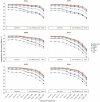Imputation-Aware Tag SNP Selection To Improve Power for Large-Scale, Multi-ethnic Association Studies
- PMID: 30131328
- PMCID: PMC6169386
- DOI: 10.1534/g3.118.200502
Imputation-Aware Tag SNP Selection To Improve Power for Large-Scale, Multi-ethnic Association Studies
Abstract
The emergence of very large cohorts in genomic research has facilitated a focus on genotype-imputation strategies to power rare variant association. These strategies have benefited from improvements in imputation methods and association tests, however little attention has been paid to ways in which array design can increase rare variant association power. Therefore, we developed a novel framework to select tag SNPs using the reference panel of 26 populations from Phase 3 of the 1000 Genomes Project. We evaluate tag SNP performance via mean imputed r2 at untyped sites using leave-one-out internal validation and standard imputation methods, rather than pairwise linkage disequilibrium. Moving beyond pairwise metrics allows us to account for haplotype diversity across the genome for improve imputation accuracy and demonstrates population-specific biases from pairwise estimates. We also examine array design strategies that contrast multi-ethnic cohorts vs. single populations, and show a boost in performance for the former can be obtained by prioritizing tag SNPs that contribute information across multiple populations simultaneously. Using our framework, we demonstrate increased imputation accuracy for rare variants (frequency < 1%) by 0.5-3.1% for an array of one million sites and 0.7-7.1% for an array of 500,000 sites, depending on the population. Finally, we show how recent explosive growth in non-African populations means tag SNPs capture on average 30% fewer other variants than in African populations. The unified framework presented here will enable investigators to make informed decisions for the design of new arrays, and help empower the next phase of rare variant association for global health.
Keywords: Genomics; Imputation; Statistical Genetics; array design; tag SNPs.
Copyright © 2018 Wojcik et al.
Figures






References
-
- Banda Y., Kvale M. N., Hoffmann T. J., Hesselson S. E., Ranatunga D., et al. , 2015. Characterizing Race/Ethnicity and Genetic Ancestry for 100,000 Subjects in the Genetic Epidemiology Research on Adult Health and Aging (GERA) Cohort. Genetics 200: 1285–1295. 10.1534/genetics.115.178616 - DOI - PMC - PubMed
Publication types
MeSH terms
Associated data
Grants and funding
LinkOut - more resources
Full Text Sources
Other Literature Sources
Molecular Biology Databases
